1000+ IG Captions to bring life to Your Photos– Nowadays everyone starts using the Instagram application on their mobile. Instagram is one of the most popular and popular Facebook photo-sharing apps that allows users to share photos and videos. Instagram is a fun way to share images and videos with friends and fans. There are 500 million customers who use Instagram on phones. Here, in this article, we will share fantastic Instagram captions for couples and the latest Lyric Captions songs for Instagram 2018.

Every time you open Instagram you can see photos and videos of your best friends. While an image can say thousands of words, words can improve an image by telling a story, providing context or adding an air of mystery. Instagram captions can help you complete your Instagram post. You can add an Instagram caption to direct clients to your biography link, share quotes about selfies or increase social media engagement. In this article, you will learn what an Instagram caption is because you should use one and suggestions to write the best Instagram captions.
You’ll also find a list of fantastic Instagram captions that you can use for your photos. This application may also be available in the Google Play Shop and in the Apple App Store. It can support Android, iOS and Windows Phone. It is completely free to use on any smartphone; You may not have to pay anything. You can transform everyday photos and movies with the best legend. Here I show you one of the best sayings on Instagram. If you are a normal Instagram user, then you know that Instagram allows users to configure captions. Instagram is one of the most popular applications in the world and it is important that it is updated with the full Instagram profile and for this, you need Instagram captions that will fully capture the eyes of your profile and will make you a message or follow-up.
What are Instagram captions?
An Instagram caption is a description or explanation written in Instagram’s photo to provide more context. Instagram captions can include emoji, hashtags, and tags. Here is an example caption on Instagram: Anna Kendrick has posted a photo of her with a cute animal. His Instagram captions said, “He followed me home, but can I save it?” In this case, the captions help give a context to why he took a picture with this animal. She told a story about prayer about how she followed her home, but she probably took the picture because she thought it was cute (just look at her face!) And she wanted to keep it. This is the text that you post below your photo.

This can be short, fun, whatever you want. This section, the captions, has a limit of more than 1000 words: there is a lot of space to add something. In addition to the striking text with which we are going to help you, you can also tag your friends with “@”. When you type @, Instagram displays a drop-down list of potential people you can tag. Start typing your friend’s name and it will be displayed. Label it by clicking on the name. After the nice captions and the labeling, you can also include the so-called hashtags.
Best Instagram captions and selfie quotes:
In recent years, the selfie has adopted social networks, even if going on a good selfie on Instagram could be difficult, thinking about some good estimates or self-help captions … Well, sometimes it can be even harder. But it is essential that you have an excellent self-portrait caption in your images and articles since it is the price of the selfie or the caption in which the users decide if it is likely that you like your photo or that you follow your page or not. That’s why we provide you with a wonderful list of some of the best selfie phrases and Instagram Caption 2018 for selfies. From creative, fun, to fantastic self-help captions: we have the best captions and quotes for selfies.
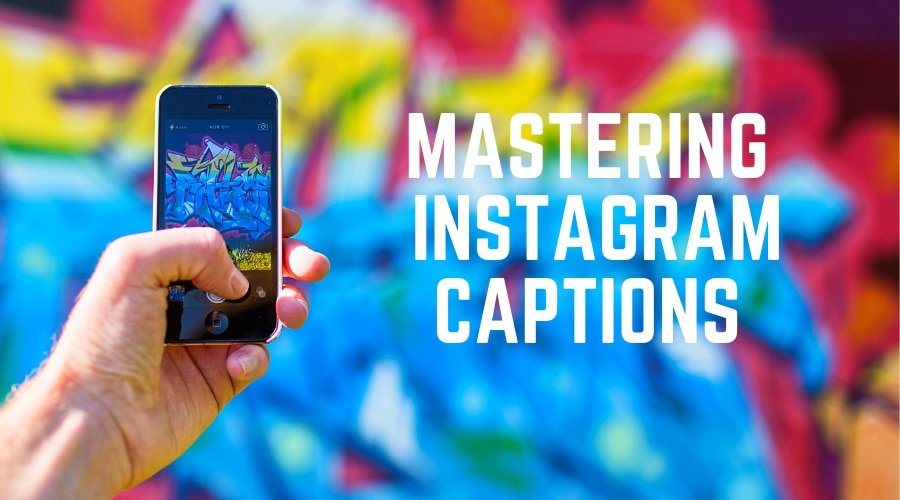
Having an excellent Instagram caption is very important! It can be the difference between receiving many items that I like and not finding them. But thinking about big affirmations on Instagram can be a challenge, especially considering that it’s easy to exhaust the ideas of Instagram captions when you post many photos. If you are a Selfies lover, then you know that your Instagram post is incomplete without a perfect caption on Instagram. Always take fantastic pictures of the fun places you are exploring, but do not know which Instagram captions you should use.
How to write Instagram captions?
Ask for something: The posts with the highest participation tend to have Instagram captions that require something. You can ask friends for labels like “tag a friend who wants this shirt.” You can also use the Instagram caption to ask a question like “What do you think about this aspect?” And, of course, you can request a purchase by asking people to click on the biography link. When asking for something, involve your audience and strengthen your relationship with them. All Instagram captions make people talk, share or buy.
Caption’s character limit: The character limit of Instagram captions is 2,200 characters. How many words are 2200 characters? About 330 words, more or less. Take advantage of this character limit from time to time. Some days you can choose to write a caption on Instagram with a series of emojis, but on other days you can decide to share a story. With 2,200 characters, you can clearly communicate the context to complete your Instagram post.
Use emojis as easter eggs: If you have a large and loyal audience, you can use the emojis to leave the Easter eggs in the Instagram legends. What is an easter egg? These are small suggestions that send messages without explicitly saying anything. For example, Britney Spears uses Apple emojis for several weeks. It is said that he has a new single called Apple Pie. And although he never confirms anything about the single, he continues to use apple emoji to make the fans hysterical. If you have an imminent release or an ad that you want to make a suggestion, you can use emoji in Instagram legends to create hype.
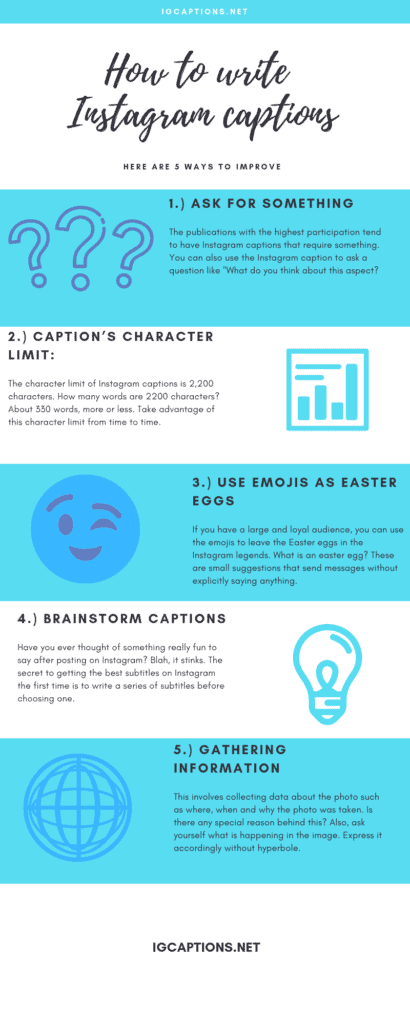
Brainstorm captions: Have you ever thought of something really fun to say after posting on Instagram? Blah, it stinks. The secret to getting the best captions on Instagram the first time is to write a series of captions before choosing one. You can create a short list of ideas, browse the hashtags to get inspired or look up the terms of your keyword.
Ultimately, you must first decide what shade you want for the caption. Do you want to share a sincere story or make someone laugh? Once you know the tone you want, you can devise caption ideas to see what works best for your photo.
Gathering information: This involves collecting data about the photo such as where, when and why the photo was taken. Is there any special reason behind this? Also, ask yourself what is happening in the image. Express it accordingly without a hyperbole.
Instagram Quotes:
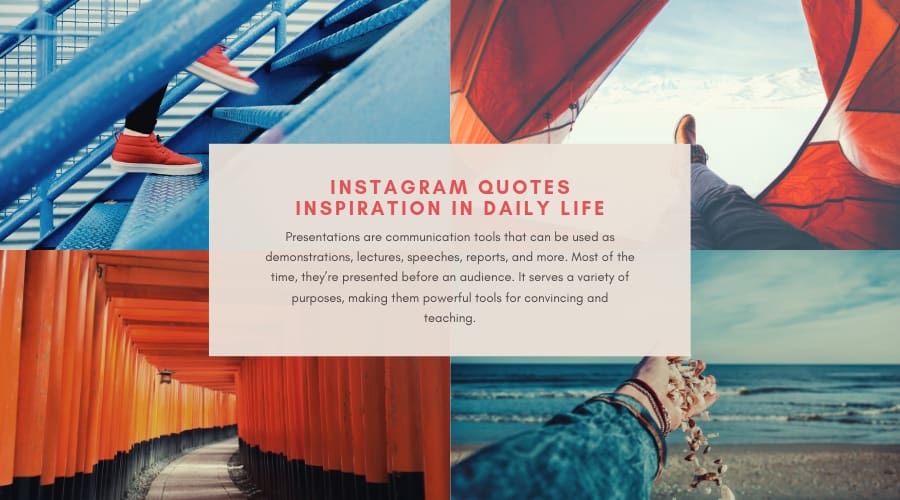
Here are some Instagram quotes that will spice up your Instagram game and make your Instagram look professional.
- Be a warrior, not a more worried one.
- Go crazy for a while
- Rolling with friends
- When you’re Downie, eat a cookie.
- Everything we have is now.
- We had that feeling of Friday.
- Catch the flights, not the feelings.
- Disappointed but not surprised.
- How I feel when there is no coffee. Depressed!
- 50% wild. 50% sweetness
- I never feel sexy. If people call me cute, I’m happier.
- It is not the amount we have, but what we like, what happiness does.
- The most important thing is to cherish life, to be happy, it is all that matters.
- Life is not a problem to solve but a reality to experience.
- I love those who can smile in trouble, who can gather forces of anguish and be brave with reflection. It is a matter of small minds shrinking, but those whose hearts are firm and whose conscience approves their conduct will persecute their principles until death.
- For a long time, I realized that successful people rarely sat down and let things happen to them. They went out and got into things.
- Love can be disinterested, in the sense of being benevolent and generous, without being disinterested.
- When I feel a bit depressed, I put on my favorite heels and dance
- Women drive my engine.
Read more about Inspirational Instagram Captions to motivate your Followers!
Instagram Quotes for couples:
Love is in the air. Couples always love to share their love on Instagram, although it is more important to share it in person, of course. However, the #couplestravel movement is huge and there are many romantic captions on Instagram to travel.

Here are some ideas for you:
- Love is a fiery friendship. In a good way …
- Get out of my comfort zone without bothering him.
- Romanticism is the glamour that transforms the dust of everyday life into a golden mist and more.
- I’m a romantic fool, no doubt.
- You make me happy in a way that nobody else can do.
- Not only are you my partner, but you are also my best friend, my partner in crime …
- I love you today and tomorrow, next week and next year and for the rest of my life.
- Only with you, it is special.
- If someone cares about you, you will never have to ask how they feel, they will constantly remind you.
- I love you more than chocolate.
- When you look at me, when you think about me, I’m in heaven.
- The world is a book. Do you want to read it together?
- What made you fall in love with him? He never asked me to justify my past.
- So please keep me close and let all this pain go away.
- You can not force them to love you. Either they do it or not. Recognize the difference and proceed accordingly.
- When God gives you a “No” give him a ” THANK YOU”. He protected you from less than the best of him.
- Sometimes what you want does not deserve you.

- Don’t let people know too much about you.
- Sometimes we have to let go of what is killing us, even if it is killing us to let us go.
- It is easy to be with the crowd. It takes courage to be alone.
- You know you’re happy when you find yourself smiling even when there’s nobody around.
- I like to go out with people that make me forget to see my phone.
- I do not see that paradise is much better than this.
- Sometimes, the nightmares we face are the dreams we used to pursue.
- I have been alone since the first day. You surprise me by thinking that something could have changed.
- The sky in his eyes, the hell behind mine.
- And tonight I’ll sleep with you in my heart.
- You can’t rush something you want to last forever.
- People do not cry because they are weak. It’s because they’ve been strong for too long.
- The feelings are just visitors, let them come and go.
- The only person you need in life is the person who proves that he needs you in theirs.
- People play with your feelings until you have more feelings.
- My favorite part of the day is sleeping with you and waking up next to you.
- I still remember our first kiss.
- I love you much more than yesterday and less than tomorrow.
- Your defects are perfect for the heart that wants to love you.
- Together it’s my favorite place!
- With you, it’s double the fun and half the problem.
- There is only happiness in this life, to love and be loved back.
- I want to stay with you until my last page.
- I think you suffer from a lack of vitamins.
- My best love was chocolate. Then you came out there.
- You are my today and all my tomorrow.
- “I love you, you annoy me more than I thought possible, but … I want to spend every minute irritating you.”
- Another way to find more quotes is to watch the romantic songs.
Read more about Wedding Instagram Captions & Quotes for Wedding Photos!
Instagram Love quotes:

- With you, I forget all my problems. With you, time remains motionless.
- We come to love not finding the right person, but learning to see perfectly an imperfect person.
- When I fell in love with you I fell hard.
- If you ever write a story about my life, don’t be surprised if your name appears billions of times.
- I want you to be happy, but I want you to be happy only with me.
- It will always be YOU.
- If you are mine, you are mine. I do not like to share
- Nothing can replace you!
- I love you This is all I know.
- I’m not perfect but I’m loyal.
Read more about Best Instagram Love Captions for Cute Couples 2019!
Instagram Funny captions:
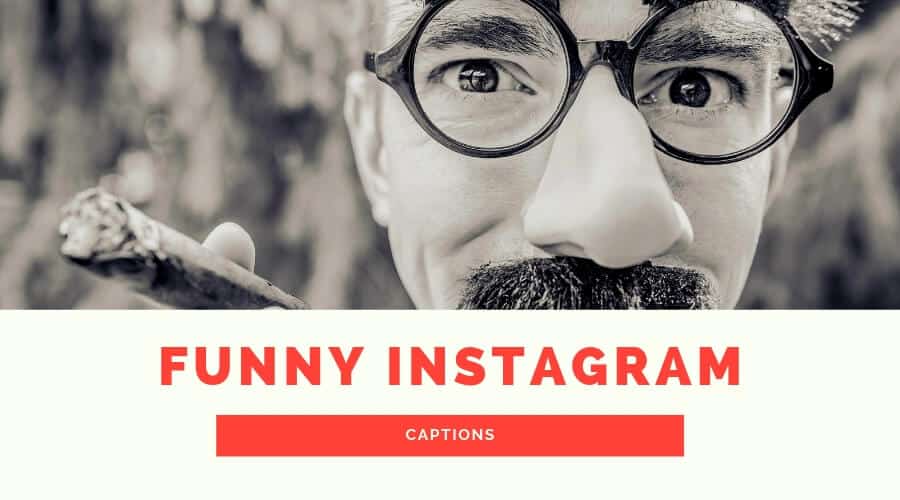
We’re going to open this list with funny Instagram captions on lol.
- Enjoy at least one sunset a day! – modern Family
- They say they do not try this at home … so I went to my friends’ house!
- My bed is a magical place, I suddenly remember everything I had to do.
- Friday is my second favorite word with the f.
- If there was a prize for being lazy, I would send someone to take it for me.
- They say to do what you love and the money will come to you. I just ordered pizza, now I’m waiting.
- For me, the math class is like watching a foreign movie without subtitles.
- Maybe if we tell people that the brain is an application, they will start using it.
- When nothing goes well, change direction.
- A policeman took me out and told me “Documents”, so I said, “Scissors, I win!” And I left.
- Mom: Why is everything on the floor? Me: gravity!
- Of course, I do marathons. On Netflix.
- I followed a diet but it did not follow me, so I did not follow it anymore.
- When Jessica Biel becomes pregnant, I hope you call her son “Mo”.
- Dear dream: thanks for trying, but you can not beat the network.
- I do not think inside the box and I do not think outside the box either I do not even know where the box is.
- I run? Yes … Out of time, patients and money.

- I find myself telling myself: just another cookie. Only another movie. One more minute. And yet … I would not call them lies!
- I like hashtags because they look like waffles.
- ETC. End of the ability to think.
- I know that the voices in my head are not real … but sometimes their ideas are just fantastic!
- Friday my second favorite word with the f
- Life is not perfect… But my hair is!
- I did not choose the life of a criminal, my life as a criminal chose me.
- When I was in Rome … I did exactly what the Romans did.
- I am back with my Ex … Box 360
- Lost in the world that does not even exist.
- Today I will be useless as letter “g” for lasagna.
- Do you drink only diet soda? You must be so healthy.
- The worst time to have a heart attack is during a “game of charades”.
- The moment she says you’re cute.
- If we could only go back in time …
Read more about Funny Instagram Captions to bring Life to Your Photos!!
Sassy Instagram quotes:

- Life goes on with you or without you.
- 5’2 my height but my attitude 6’1
- Do not study me. You will not graduate!
- His wild attitude, but his heart is golden.
- Own what is yours, otherwise, others will try to do it.
- Life goes on with you or without you.
- Do not confuse my kindness with weakness.
- You could not even handle me if I came with the instructions.
- Sorry if. Forget it, never.
- There is a hole in my heart where you are used to.
- I do not need part-time people in my life.
- I got it from my mother.
- Thick thighs and beautiful eyes.
Read more about Sassy Instagram Captions for flawless Insta Pictures!!
Instagram Captions for Best friends:

- There is nothing better than a good friend, but a good friend with chocolate.
- Friends buy you food. Best friends eat your food.
- Friends make this world beautiful.
- Friends won’t let you do stupid things … alone!
- All you need is someone to join your strangeness.
- Normal? Only people you do not know well enough are normal.
- Friendship is essentially an association.
- In my friends, I find my second half.
- Best friends They know how crazy you are, but I agree with you in public.
- True friends never separated. Maybe at a distance but never in the heart.
- Hard times will always reveal true friends.
- Making new friends should not mean losing the old ones.
- Friends are the family we have chosen.
- Studying means reading 10% and 90% complaining to your friends that you have to study.
- The best medicine is a true friend.
- Friendship: when a friend calls you in the middle of the night to say “Get ready, I’ll pick you up in 30 minutes!” And you will respond only “done!”
- You and I are really more than friends. We are like a very small band.
- Friends are like stars, they come and go constantly, but those who remain burned like the sun
- A good friend can know your wild stories, but your best friend was there with you
- I would never let my best friend do something stupid … just
- Laugh at random things. Celebrate until dawn. There is nobody else that I would like by my side. I love you
- Hold on to your best friend because you will never find someone like them again.
- My best friend returns in the old days because he is quiet and shy. I turned it into a monster. ????
- Find someone who can bring out the best in you.
- A best friend is like your favorite bra: supportive, comfortable, hard to find and close to your heart as well
- A best friend will love you when you are too sad to love yourself
Read more about Instagram Caption for Friends 2019!!!
Insta short captions:

- A human being without a friend is like a tree in a desert.
- Your loss, baby.
- It could hurt you to look back in the past or be afraid to think what the future holds for you, but those things might not happen if you have a best friend in the present with you.
- We are only who we really are.
- Life is short to wear nice shoes.
- When you do not believe in yourself, your best friend believes in you.
- Do what makes your soul shine.
- Depending on the story behind the photo
- Life is the way to shorten negative vibrations.
- Sometimes you just do not need a doctor, sometimes your best friend is therapy.
- When nature is your home, do not visit it.
- Long legend of my closest friends and less than others
- If you listen carefully, Earth has a lot of music for you in the store.
- Loving and being loved by the same person is the best feeling in the world.
- You make my heart smile.
- A true friend sees the first tear, takes the second one and stops the third.
- When your happiness is less important than the happiness of the other, my friend is in love.
Read more about One Word Captions for Instagram Photos to get more likes!!!!!
Instagram Cute quotes for selfies:

- The most precious gift you can receive is an honest friend.
- You can love a person more than any other person in the world, but that does not matter until you love yourself.
- Be a good human
- O.L.D: Wait; End of the pain
- One true friend is the greatest of all blessings.
- You were very happy during your childhood.
- The risk is better than regret
- Be so good that they can’t ignore you.
- Wherever we are, it is friends who make our world.
- You can fall in love with someone else’s beauty, but sometimes you fall in love with the millions of things they do.
- Hot chocolate time
- Friends are the most important ingredient in the recipe called ‘life’.
- He turned his back on me and I took it, always.
- Life is short with pretty shoes.
- One of the best things in life is a good friend!
- Life is not perfect but every second with “you” is.
- The sea in the morning
- Your hair is 90% of your selfies.
- In my friend, I find a second me.
- Worry less, smile more …
Read more about 200+ Selfie Captions for Beautiful Selfies!
Tips To Get More Instagram Followers:
Good Instagram captions:
- I know I'm lucky to be so cute.
- Some days start better than others.
- The truth is that I'm crazy about you. And everyone can see it, but you.
- Sometimes life surprises you with a happy coincidence.
- One not just "Let it go".
- Is Google a boy or a girl? Obviously, a girl because she does not allow you to finish the sentence without suggesting other ideas.
- It is so beautiful when a child smiles.
- Do not be like the others, honey.
- Girl, I have to return the call.
- Sit down, we've been waiting for you.
- Finally, I counted.
- My God, it's so cute
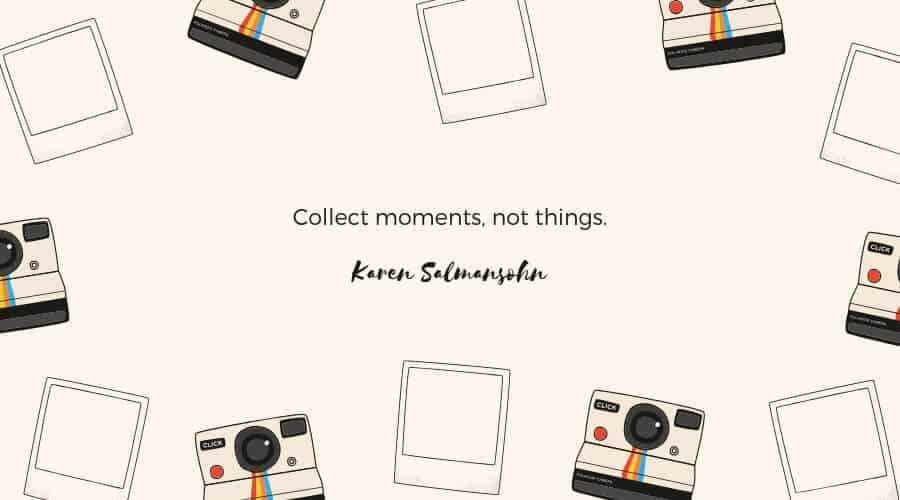
- Life is not perfect, but my hair is!
- The best thing I did was to believe in myself.
- Judge me when you are perfect.
- Be yourself People need to like you and you do not have to worry about that.
- Stay away from people who make you feel you are hard to love.
- Drop anything that is toxic to your progression.
- One of the biggest mistakes we make is to assume that ‘other people’ think the way we think.
- Taking care of what people think about you is useless. Most people do not even know what they think of themselves.
- Watch more Netflix sunsets.
- Hey, I just met you, it's crazy.
- At least this ball attracts me!
- I have to destroy you with kisses and hugs.
- Stop looking for happiness in the same place where you just lost it.
- I woke up like this.
- I decide on the environment.
- Nobody is you This is your power!
- I have my coffee and donut.
- Escape from the ordinary.
- Sweeter than honey
- Demonstration that I can do selfies better than you
- A friend will always make you smile, especially when you do not want to ...
- This is for the echoes of our laughter. The looks we share Endless gossip. and the sudden surprises escapes. This is for our past and this is for our future. This is for our friendship that will never fade.
- Life is not perfect ... But my hair is! #selfieaddict
- Always classy, never careless and a little impertinent.
- New haircut and work preparations.

- A friend is someone who makes it easy to believe in yourself.
- They always appear to me.
- Dream without fear love without limits.
- Whatever you sprinkle your donuts
- Looking at your best friend and saying "I'll do it if you do it".
- Making our memories sweet is my favorite activity.
- The dust of wonders and the city
- I'm not taking a selfie, I'm just checking the quality of my camera
- Friendship is born the moment one person says to the other: "What, you too? I thought I was the only one.
- I remember the first day that I looked you in the eyes and felt that my whole world was vibrating.
- Oh honey, after all, all you have is yourself.
- You do not have to be crazy to be my friend. Give it time It will happen eventually.
- A balanced diet is a bar of chocolate in both hands.
- Please, do not download my Selfie, you could fall in love with me.
- Best friend, less cleaning you do before it arrives.
- Cute and elegant short Sassy
- Selfie in paradise
- True friendship is when your friend comes to your house and then takes a nap.
- Be groovy or go, man.
Read more about Good Instagram Captions to bring Likes to Your Photos!!
Instagram is a camera application that becomes a social network. Instagram is a photo sharing community, where people can follow other interesting Instagrammers to see their photo stream and access their albums. You can independently create an image channel and share your best Instagram captions. The application has other fantastic features such as simple but effective special photo effects and advanced camera features. Keep reading to find out how to use Instagram on your computer!

One of the popular things these days is to use Instagram to add certain effects to your photos. This photo sharing site allows you to add old filters to each image you make to make it more dramatic and have that nostalgic touch. In addition, the site also acts as a social networking site that allows you to follow people and vice versa, which gives you the opportunity to see your photos uploaded and those that have theirs. Instagram has become even more popular because it is used by people who have iOS and Android devices, which makes it easier to edit photos before sharing them. Now, if you're wondering if there's Instagram for computer users like you, there are some things you should know.
Read more about Food Captions for Foodies to share with their Photos 2019
Many people look for the best Instagram captions for photos. If you have a good photo to post but you do not use it with the correct caption, then it's not worth it. Use the Instagram caption when necessary. This is the best practice to use captions and quotes. Sometimes it is necessary to add a brief description in a post and, sometimes, a long one. It depends on the post of Instagram. Use these Instagram captions carefully and increase your followers of Insta. Hope you all liked the article about Instagram Captions. Follow us on Instagram, Facebook, Pinterest, Twitter.

